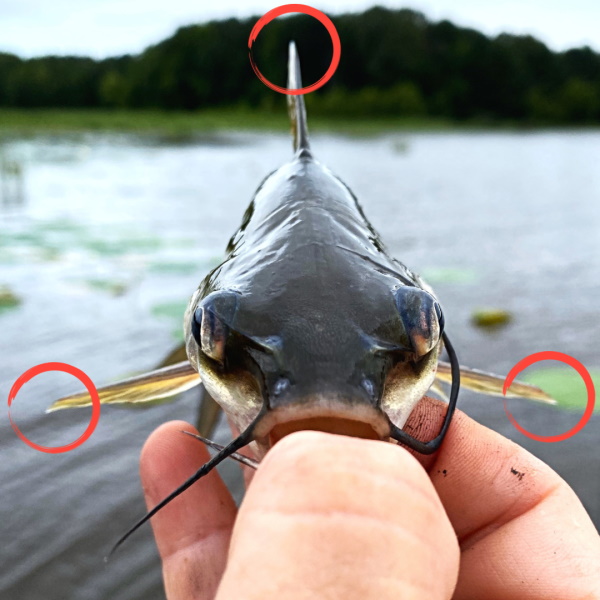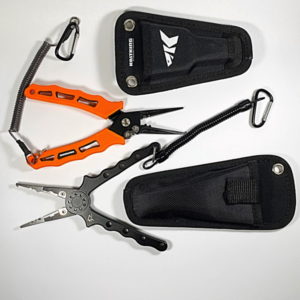
Although catfish don’t have a true stinger in the typical sense, they can certainly sting you with their pectoral and dorsal spines.
There are actually many catfish species that do in fact contain venom glands at the base of their spines. However, from my experience, the “stings” from most freshwater North American catfish are uncomfortable but not unbearable. With channel, blue, and flathead catfish, the possible secondary infection is the more serious concern.
A potential catfish “sting” is always more of an issue when dealing with younger catfish. These young cats, under 3 lbs., have extremely sharp “stingers” which turn into formidable weapons when they decide to thrash about. These spines will dull over as the fish ages, so they’re not as much of a concern when dealing with larger catfish.
How To Hold A Catfish To Prevent A Sting

For any sized catfish that I can fit my hand around, I like to firmly grasp them as shown above. Grip them from the top and behind the head and pectoral fins. When holding them like this from above, make sure you don’t let the dorsal spine puncture your palm. You can also hold them like this but with your hand underneath the fish. Either way, you have to be careful when doing so, as you never know when they will decide to flop around. A really firm grip is the key to avoiding the spines.
If a catfish is too large to hold with a single hand then their spines are usually dull enough to be of little concern.
To further eliminate risk, I would advise a novice angler to control a catfish with a lip gripper until they are more comfortable around them. The hesitancy in grabbing catfish firmly by hand is what usually gets you stuck. You have to commit to the grab and hold on tight. If you don’t feel that you can do that, it’s best to use a fish grip until you are more confident.
For really small catfish whose mouths are too small for a gripper, you can also use pliers to grasp them by their top dorsal fin.
Getting Impaled Or Stabbed By A Catfish
The dorsal and pectoral spines of a young catfish can prick or cut you badly, causing great pain. They can also quite literally impale you to the point that they are hard to remove from your flesh.
I have personally witnessed a child swing a small catfish into the calf of a nearby adult. The pectoral fin penetrated deep into the poor guy’s calf to the point that he could not bear to remove it on his own. He doubled over, groaning in agony, with a small catfish hung from the side of his leg. Fortunately there was emergency personnel already on site, as this was a kids fishing event put on by the state. They went to work immediately to pull the fish free and stop the bleeding. The point here is that you should always keep your wits about you when dealing with small catfish in particular, and especially if kids are involved. Those little cats can sure enough cause serious injury.
How To Treat A Catfish Sting
Shallow stings or pricks can usually be tolerated quite well with a good cleansing and pain meds, whereas deep punctures may require medical attention. I have been pricked many times by small catfish, and I find that the pain will subside, and the wound will heal on it’s own without any medical attention at all. Fortunately I have never suffered a deep stabbing from a catfish, but I know others that have not been so lucky.
Deep punctures from a catfish spine may require that you see a physician, especially if an infection occurs. I know of fellow anglers that have had to go to the doctor to deal with a resulting infection. If in doubt, go to a clinic and have it looked at.
How To Release A Catfish To Avoid A Sting
When it comes to safely releasing a small catfish, I find it’s best to simply drop them out of your hand and into the water. If you try to instead throw a small catfish you run the risk of their fins slicing your fingers. I learned that lesson the hard way. Instead, a quick drop by opening your hand and quickly moving it away will help you avoid a nasty cut from a flopping fish.
Conclusion
While it may seem a bit counterintuitive, you actually have to take more care when dealing with smaller catfish than with larger ones. Those tiny sharp spines of young cats are like daggers that will get you, or a nearby angler, if you’re not careful.
Some folks go so far as to handle small catfish by the dorsal fin using a dehooker or a pair of pliers. I don’t personally think you have to go to that extreme, but you should definitely exercise caution when handling them.
Stay safe out there!
Augustus Clay



